
In the late 1950s and the early 1960s, transistors could be bought in the UK that were branded 'Semiconductors Ltd', made in the UK, using the same technology and encapsulation (and sometimes the same part numbers) as those made by Philco in the USA, often quite advanced silicon devices. What was going on?
Information is scarce on this aspect of British semiconductor manufacturing history, but enough exists to sketch it out. The manufacturer of these devices was Plessey Semiconductors Ltd., a division of the Plessey company, another longstanding British manufacturer with a very diversified product range. However, the word 'Plessey' hardly ever appears on Semiconductors Ltd documentation. Plessey management was farsighted enough to kick-start their business by licensing advanced technology from the American company Philco, but then to develop their own in-house technology that was leading-edge in Europe if not the world. They purpose-built a semiconductor factory in Swindon where Plessey had other manufacturing facilities, and went from being a relatively small-scale manufacturer of transistors to become a leading and successful British manufacturer of integrated circuits in the 1980s (using the Plessey brand by then). This attracted the attention of GEC, the UK's largest electrical group. After initial attempts that were thwarted by UK monopoly laws, GEC finally teamed up with Siemens in Germany and bought Plessey in 1989. Subsequently parts of Plessey lived on in various subsidiaries of GEC that survived after GEC itself became defunct. In February 2009, one of these businesses was forced into receivership but survived after a management buy-out that was later reinforced by a second management buyout of another ex-Plessey site, the two then combining to re-create the original name of Plessey Semiconductors, now specialising in the development and manufacture of innovative products using microLED technology.
 Transistors by Semiconductors Ltd did not bear a logo other than the name 'SEMICS' in an unusual font. I have a number of original Semiconductors data sheets, but no data books. If you know anything more about the devices below, or have other information about Plessey's early semiconductor history, please
Of course, Plessey went on to become an important UK manufacturer of integrated circuits, but not individual transistors. I don't know how Semiconductors Limited morphed into this different company.
Transistors by Semiconductors Ltd did not bear a logo other than the name 'SEMICS' in an unusual font. I have a number of original Semiconductors data sheets, but no data books. If you know anything more about the devices below, or have other information about Plessey's early semiconductor history, please
Of course, Plessey went on to become an important UK manufacturer of integrated circuits, but not individual transistors. I don't know how Semiconductors Limited morphed into this different company.
I do not possess all the transistors below, in fact I am seeking many of them. It is noted in the text where I am seeking examples of any particular type: if you have some for sale or exchange, please Conversely, I am happy to help anyone looking for information on these devices. I have an extensive collection of old data sheets and books, and can provide some information on most Semiconductors Ltd types.
I do not know which type was Semiconductors Ltd's first transistor. The oldest of their data sheets that I possess are dated October 1957 and list several 2N series devices: 2N352, 2N353, 2N386, 2N387 and 2N393. The first four are germanium power transistors and the last is a germanium micro-alloy type. I have Semiconductors data sheets for more 2N types extending through to 1964. However I do not possess a single 2N device branded SEMICS, these are all Philco devices and the data sheets even give the Philco developmental part number T-nnnn.
If you have come across 2N types by Semiconductors, please
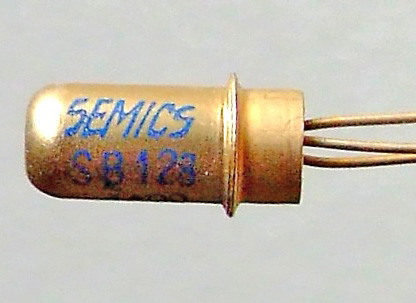
It is possible that Semiconductors Ltd's first own transistor was this type SB128, which is equivalent to the historic Philco germanium PNP surface-barrier type 2N128 from 1956. However, I don't have a data sheet for it, although it appears in their price list dated May 1960. Semiconductors Ltd also made the germanium surface-barrier types:
The SB types are marked 'UK' as are all Semiconductors transistors in my possession. The advantage of the surface-barrier technology was that the transistor gain extended to high-frequency, and so all these types are low-power RF amplifiers or oscillators, extending up to approximately 5 MHz.
I am looking for original data for SB128, SB129 and SB087, and examples of the last two: if you can help, please
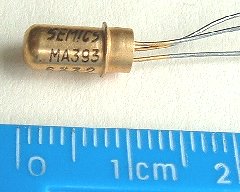
In the late 1950's Philco developed several improved transistor technologies and Semiconductors Ltd followed. After the original surface-barrier came an improved version called micro-alloy transistors (MATs). Again this was a technology developed by Philco for extending high-frequency performance. Semiconductors Ltd made a number of types:
The germanium PNP type MA393 shown is equivalent to the Philco 2N393, with the data sheet stating that it will oscillate up to 60 MHz.
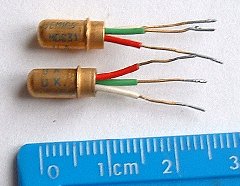
Semiconductors Ltd also followed Philco in selling germanium micro-alloy diffused transistors, or MADTs. At first they kept the American 2N numbering but later on they issued a range of germanium micro-alloy diffused transistors:
I am missing original data for most of these types, if you can help provide any, please
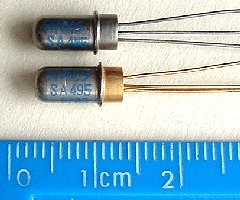
Semiconductors Ltd went on in early 1961 to produce 'surface alloy' silicon transistors:
These figures are clearly inferior to that of the company's germanium devices, but the improved power handling and stability of silicon were valuable and other characteristics would follow. The image shows rather unusual encapsulation: the SA496 is a normal metallic colour, and the SA495 is gold-plated on the lower part only. I do have other examples that are all golden.
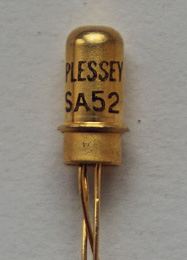
Within a few years Semics had a range of surface alloy silicon transistors:
The SA52 shown is unusual in that it is branded 'PLESSEY'. It is dated 1968 which is quite late.
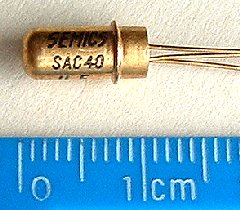
Semiconductors Ltd produced some specialised silicon surface-alloy devices: the SAC series contains 'chopper' transistors. A chopper circuit is a one that 'chops' an input signal, that is, it switches it on and off periodically. The 'chopped' signal is then processed by subsequent circuitry, and at a later stage the 'chopping' is filtered out to leave the amplified or processed signal. It is quite hard to believe, but Semics made several transistor types specifically for this purpose:
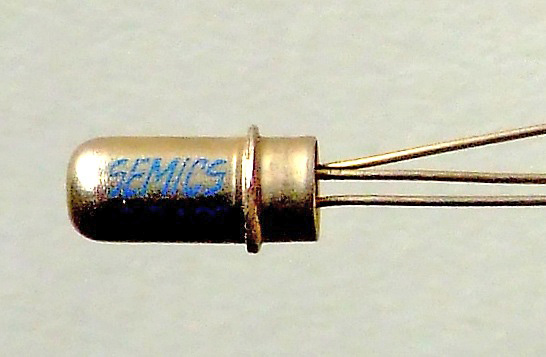
They also made some symmetrical switching types in the SSA series; this technology was believed to be advantageous in some circuit applications although there do not seem to be modern devices that explicitly mention it.
I only have the SSA43 shown.
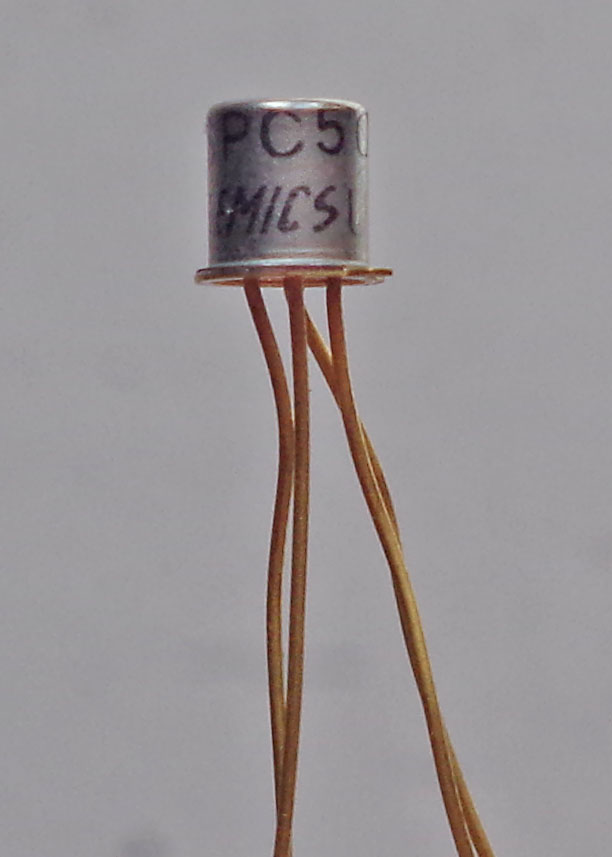
I have also discovered serendipitously from browsing the 'D.A.T.A. Book of Discontinued Transistors 5th Edition 1969' that Semiconductors Ltd made a range of silicon NPN planar-epitaxial transistors
(Don't confuse these with devices from the manufacturer SPC). The last three are double-emitter types, and thanks to Ged I have the SPC50 shown, in what looks like TO-18 outline but D.A.T.A. denote RO38. If you can help provide any of the others, or provide original data for any of them, please
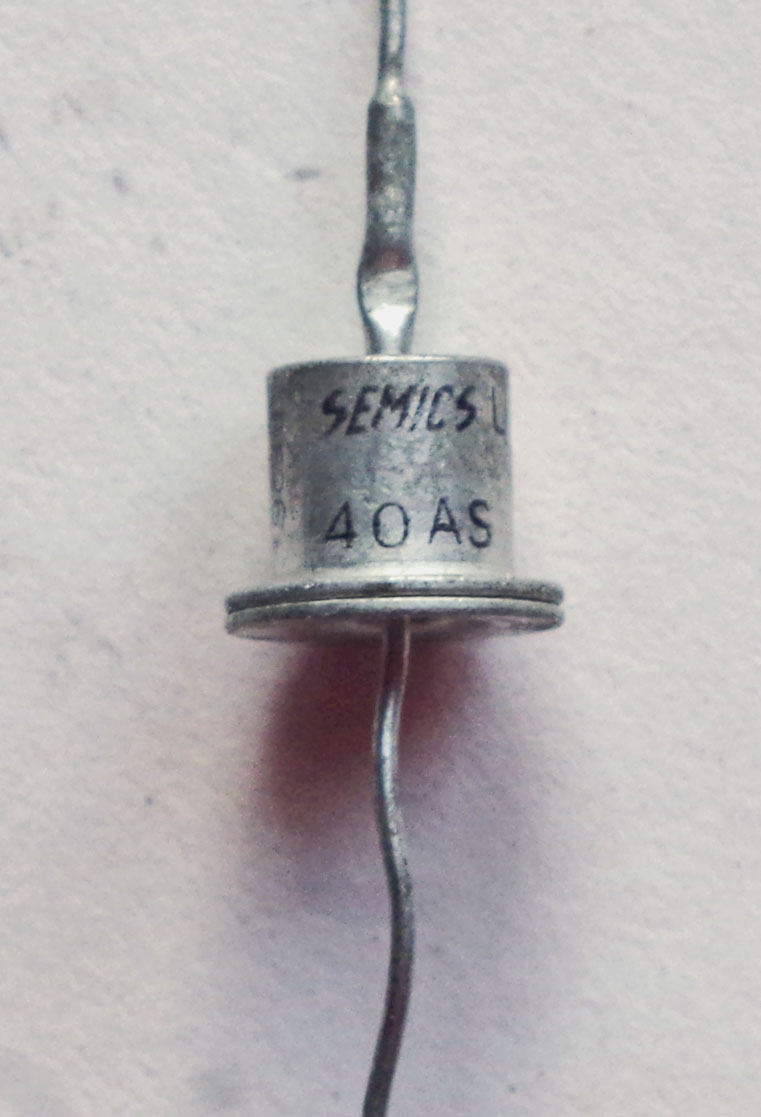
The situation with Semiconductors Ltd diodes is puzzling. I have a booklet 'Simet Silicon Rectifiers Data Book' by Plessey, dated November 1961. The introduction states
'Semiconductors Limited, at Cheney Manor, are now responsible for the production and sales of all semiconductor devices including transistors and rectifiers, and for the development of semiconductor meterials and techniques at the Caswell Research Laboratories, Northamptonshire'.
This contains no fewer than ten ranges of silicon diodes of all types from miniature switching to high-power rectifiers, as well as rectifier stacks and valve rectifier replacements. However, the only one I have is this type 40AS, which I find rather odd, as I have obtained parcels of mixed devices from hundreds of sources. Furthermore, several of the types listed do sometimes appear on eBay, but branded AEI. Did Plessey sell this part of their business?
If you know where I can find any diodes made by Semiconductors Ltd, please

In 1962, Sinclair Radionics of Cambridge, Clive Sinclair's company, started selling the 'Sinclair Micro-Amplifier'. I quote here from their advertisement in 'The Radio Constructor':
'This microscopic amplifier, the smallest of its type in the world, out-performs amplifiers 20 times as large'.
The text goes on to describe its 60dB power gain, frequency response of 30Hz - 20KHz +/- 1 dB, and power 'sufficient to drive ANY type of earpiece or even a loudspeaker'. It is claimed that the amplifier is only made possible by the 'remarkable micro-alloy transistors it uses'. These were also available separately, comprising four types: MAT100 cost 7/9d, MAT101 cost 8/6d, MAT120 cost 7/9d, and MAT121 cost 8/6d.
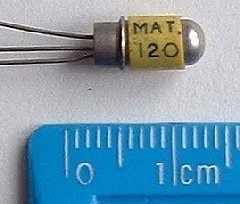
As well as the advertisement, I have booklet number 181 from the series "Bernard's Radio Manuals" entitled '22 Tested Circuits using Micro Alloy Transistors' by Clive Sinclair. This gives the characteristics of these four devices: the MAT100 is a low-gain 60 MHz type, the MAT101 a high-gain 60 MHz type, the MAT120 a low-gain 120 MHz type, and the MAT121 a high-gain 120 MHz type.
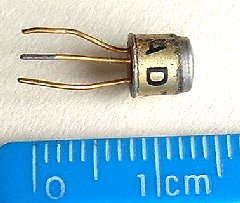
I have a second Bernard's booklet, this one number 186 without a specified author, dated August 1963 and entitled 'Tested Superhet Circuits for Shortwave and Communication Receivers using Micro Alloy Transistors (MAT's)'. This lists the Sinclair types MAT120 and MAT121, but no MAT100 and MAT101, and also the 'new Sinclair subminiature alloy-diffused transistor type number ADT140'. As shown, this used a standard TO-18 can, but again with a label stuck on it.
Elsewhere on the Web it is claimed that the Sinclair transistors were 'rejects' that he bought cheaply and selected himself. This only seems possible to me if they were unable to meet their frequency specification but still possessed the high gains quoted for the MAT101 and MAT121. Another possibility is that Sinclair simply bought in bulk, either from Semiconductors Ltd or directly from Philco. He states in his book that the MATs are low-price because of high-volume fully-automated production. Some are plain metal coloured as shown and some are gold-plated like Semiconductors Ltd devices, but all my examples have labels stuck around them. Judging from their characteristics, I can guess that they might be low-spec examples of types 2N499 (100 MHz) and 2N500 (200 MHz), more-or-less the last MADTs that Philco produced in this encapsulation.

Intriguingly, I possess a data sheet dated October 1964 that lists a series of integrated circuit amplifiers made by Semiconductors Limited:
These are all single-chip 15 MHz amplifiers in either a TO-18 or a TO-5 outline (8-lead TO-5 in the case of SL20). I believe that they were later issued under Plessey branding. I would be interested to find examples of these. If you know where I can, please